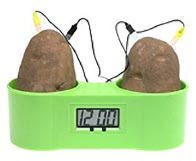Search:
Page Number:
Electricity Grows on TreesSkills Reference 2 Skills you Will Use
Safety
Caution In this lab you will be using sharp pieces of wire and nails, so take care not to poke yourself. The production of voltage from an electrochemical cell requires an electrolyte and two different electrodes. The electrolyte is a substance that attacks one or both of the electrodes, resulting in the movement of electrons. As it turns out, many fruit and vegetables contain natural juices that can serve an electrolyte. For example, a common hobby science kit that can be purchased is a potato clock. 
In this activity, you will use apples to create electrochemical cells and use them to try to power a calculator. QuestionHow can you make a wet cell out of common household materials? 
Materials and Equipment
Dry LabA "dry lab" activity includes collected data and/or a video solution for your convenience. You can simply watch the following video and use the provided data, or if you wish to perform this lab for yourself, follow the procedure steps 1 through 9 described in the video. The same steps are included in written form in the documents available for download on the bottom of this page. Analyzing and Interpreting
Skills Practice
Forming Conclusions
|